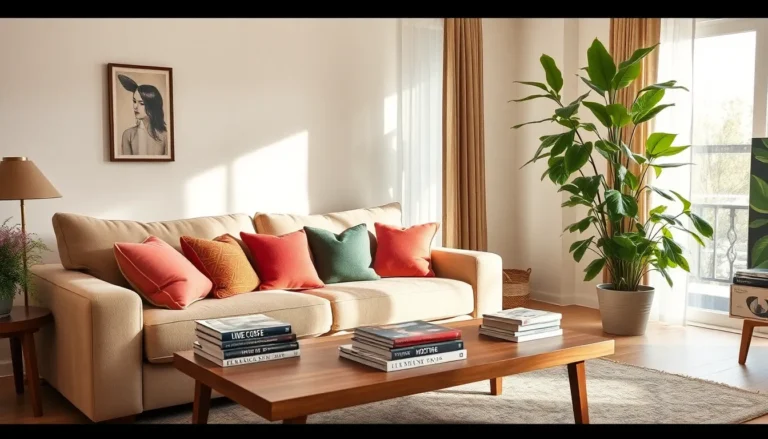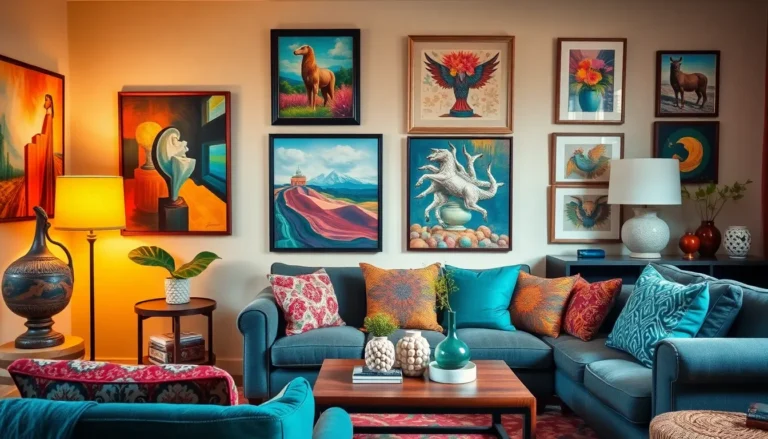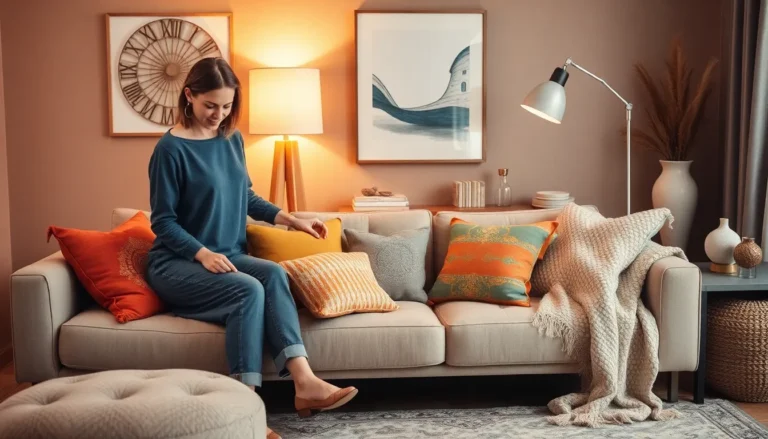Table of Contents
ToggleThe dining room is more than just a place to eat; it’s the heart of the home where memories are made and awkward family conversations unfold. Imagine transforming that space into a stylish haven that not only impresses guests but also makes every meal feel like a special occasion. After all, who wouldn’t want a dining room that screams sophistication while whispering, “Please, stay for dessert”?
Overview of Dining Room Interiors
Dining room interiors play a crucial role in enhancing the overall atmosphere of the home. Designers focus on combining aesthetics with functionality to create spaces that resonate with personal style. Various design elements contribute to the dining room’s ambiance, including furniture, lighting, colors, and decor.
Furniture choices impact comfort and style. A large dining table accommodates family gatherings, while chairs add character and encourage congeniality. Options such as upholstered chairs or elegant wood designs cater to diverse tastes and preferences.
Lighting fixtures significantly affect the mood. Pendant lights above the table can create a focal point, while dimmable LED lights enable flexibility for different occasions. Layered lighting, combining ambient and task lighting, enhances visibility while adding depth.
Color schemes dictate feelings within the space. Neutral palettes evoke tranquility, while bold hues can energize the environment. The use of patterns in textiles or wall coverings contributes to visual interest and can reflect seasonal changes.
Decor items, such as artwork or centerpieces, personalize the dining area. These elements allow homeowners to express their unique tastes. Incorporating plants adds life and freshness, connecting indoor spaces with nature.
Overall, a well-designed dining room interior not only supports daily meals but also fosters memorable gatherings. Thoughtful selections and arrangements create an inviting atmosphere that encourages meals to become cherished experiences.
Popular Styles of Dining Room Interiors

Various styles of dining room interiors cater to different tastes and preferences. Each style enhances the dining experience, creating a unique atmosphere for gatherings.
Modern Dining Room Interiors
Modern dining room interiors emphasize minimalism and clean lines. Designers often incorporate sleek, angular furniture pieces along with open spaces. Neutral color palettes paired with bold accents create striking contrasts. Statement lighting fixtures serve as focal points, further enhancing the ambiance. Incorporating natural materials like wood or metal adds warmth to the modern aesthetic. Unique elements like geometric shapes often provide artistic flair.
Rustic Dining Room Interiors
Rustic dining room interiors draw inspiration from nature and farmhouses. Natural wood furniture is a staple, often featuring distressed finishes. Earthy color schemes create a warm, inviting atmosphere. Accessories such as woven textiles and artisanal decor add a homely touch. Large dining tables made from reclaimed wood foster a sense of community. Enhancing the rustic vibe, vintage elements and exposed beams are commonly integrated.
Traditional Dining Room Interiors
Traditional dining room interiors emphasize classic elegance and timeless design. Rich wood finishes dominate furniture choices, often rich in detail and craftsmanship. Deep jewel tones in upholstery or paint evoke sophistication and warmth. Formal dining tables paired with upholstered chairs create a refined look. Chandeliers or sconces provide ambient lighting, enhancing opulence. Family heirlooms and ornate decor pieces contribute to the room’s character.
Key Elements of Dining Room Interiors
Dining room interiors encompass various elements that significantly enhance the space. Key components include color schemes, furniture selection, and lighting options, each contributing to the overall atmosphere.
Color Schemes
Color schemes greatly affect the mood of a dining room. Warm tones, such as deep reds or rich oranges, encourage a welcoming environment. In contrast, cool colors like blues and greens create a calm ambiance. Neutral shades offer versatility, easily complementing various decor styles. Selecting a cohesive palette ensures harmony throughout the room, allowing accessories to blend seamlessly. Additionally, accent walls can add depth and interest, while carefully chosen textiles inject personality.
Furniture Selection
Furniture selection plays a critical role in both style and functionality. A robust dining table serves as the focal point, accommodating family and guests. Chairs should provide comfort while reflecting the room’s aesthetics. Bench seating offers a casual vibe, while upholstered chairs add elegance. Storage solutions, such as sideboards or cabinets, increase practicality without sacrificing design. Choosing materials is essential; wood adds warmth while metal brings a contemporary edge. Ensuring the furniture fits the space enhances movement and usability.
Lighting Options
Lighting options significantly impact the dining experience. Overhead fixtures, such as chandeliers, create a striking focal point while providing ambient light. Pendant lights can offer a more casual touch, ideal for various styles. Task lighting, such as wall sconces, ensures functionality during meals. Dimmers allow for adjustable brightness, catering to different occasions. Incorporating layered lighting creates depth, combining ambient, task, and accent lights for a well-rounded atmosphere. Thoughtful placement of fixtures enhances the overall design while ensuring the space feels inviting.
Tips for Designing Dining Room Interiors
Creating a functional and inviting dining room requires thoughtful design choices. Implement space optimization and personalization touches to enhance the overall atmosphere.
Space Optimization
Maximize available space in the dining room to ensure comfort and flow. Consider using round tables, as they often fit snugly in tight areas while promoting easy conversation. Arrange furniture to encourage natural movement, ensuring ample room for dining chairs and guests. Incorporate multifunctional pieces, such as benches or storage units, that can serve dual purposes without cluttering the space. Utilizing vertical storage solutions like shelves or cabinets frees up floor area while providing necessary storage. Finally, choose a layout that fosters intimacy, encouraging meaningful connections among diners.
Personalization Touches
Add personal elements to the dining room to make it uniquely yours. Display artwork that resonates with your tastes, enhancing the visual appeal and sparking conversation. Consider using decorative tableware, such as colorful plates or unique centerpieces, to showcase your style during meals. Incorporating family heirlooms or travel souvenirs adds character and warmth to the space. Plants, whether real or artificial, improve air quality while bringing a touch of nature indoors. Personalized lighting fixtures can also serve as statement pieces, illuminating the dining table and enhancing the ambiance for every occasion.
Conclusion
A thoughtfully designed dining room serves as more than just a place to eat; it’s a space for connection and celebration. By blending style with functionality, homeowners can create an inviting atmosphere that enhances every meal.
The choice of furniture, lighting, and color schemes plays a crucial role in shaping the dining experience. Each element contributes to the overall ambiance, allowing for personalization that reflects individual tastes.
Whether opting for a modern, rustic, or traditional style, the dining room can be transformed into a memorable setting. With careful consideration and creativity, it becomes a cherished space where lasting memories are made.







